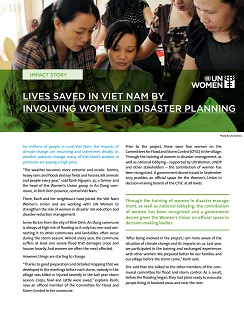Disaster risk reduction
Disaster risk reduction (DRR) involves reducing disaster risks through efforts to analyse and reduce their causes. Gender-responsive disaster risk reduction refers to analysing and taking into account the needs, opportunities, roles and relationships of women, men, boys and girls formed by gender norms within a given culture and society. It requires specific attention to women’s rights and gender equality as part of a proactive and people-centred approach to reducing risks and vulnerabilities.
Disasters affect women, men, boys and girls in different ways. Gender inequalities increase women’s and girls’ vulnerability because they limit women’s and girl’s access to information and resources. This makes it more difficult for them to be resilient and recover from disasters.
The international community has recognized and committed to a strong focus on gender equality and women’s rights in disaster risk reduction.
This requires:
- gender-responsive governance and policy-making,
- gender-responsive programming, monitoring and evaluation,
- integration of gender into vulnerability, risk and capacity assessments,
- the collection and use of sex- and age-disaggregated information and data,
- facilitating and leveraging the actual and potential contributions and leadership of women in resilience building,
- and promoting their participation, leadership and voice in disaster risk reduction processes.
Our solutions
At the country level, UN Women works hand-in-hand with governments and civil society to strengthen contributions and leadership of women in disasters and increase their resilience.
In response to the Super Cyclone Pam in Vanuatu, the 2015 earthquake in Nepal, and extensive flooding in Myanmar in 2015, UN Women supported national disaster management bodies and women’s advocates to ensure the disaster response and recovery process was shaped by women’s perspectives and responded to the common and differentiated needs of women, men, boys and girls.
In Bangladesh, Tajikistan and Kenya and in close cooperation with partners, UN Women has been supporting the governments to develop gender-responsive national plans and strategies for disaster management in line with the Sendai Framework for Disaster Risk Reduction.
In Viet Nam, after the drought and salt water intrusion of 2016, UN Women supported gender-sensitive assessments and led advocacy efforts for women on response and long-term recovery measures. Gender-specific issues were highlighted in joint needs, food security and livelihood assessments, and joint monitoring missions.
At the regional level, together with UNISDR, UN Women successfully advocated in November 2016 for the development and adoption of a gender-responsive “Asia regional plan for the implementation of the Sendai Framework”. As a result, the region’s Member States firmly committed to gender equality and women’s empowerment throughout the implementation of the Framework.
At the global level, UN Women is emphasizing the gender dimensions of disasters as an issue of DRR effectiveness, not only one of equal rights and opportunities. For the Sendai Framework for Disaster Risk Reduction, which was adopted in March 2015 in Sendai, Japan, UN Women provided technical support to Member States and the Secretariat along with civil society organizations and other UN entities. This included key recommendations and a sector brief on gender-responsive disaster risk reduction, and awareness raising on gender equality and the need for empowerment and leadership of women in natural disasters. In particular, UN Women has advocated for strengthened language relating to women’s equal participation and leadership, increased collection and use of sex- and age-disaggregated data, gender analysis as well as inclusion of gender-responsive targets and indicators in the Sendai Framework for Disaster Risk Reduction.
At the fifth Global Platform for Disaster Risk Reduction in May 2017, UN Women co-hosted a special event on “Women’s leadership in disaster risk reduction” to bring greater attention to the gender inequality of risk and highlight best practices, lessons learned and recommendations for gender-responsive implementation of the Sendai Framework. In partnership with IFRC and UNISDR, UN Women also launched the “Global programme in support of a gender-responsive Sendai Framework implementation: Addressing the gender inequality of risk and promoting community resilience to natural hazards in a changing climate” (GIR).The GIR provides a mechanism to support countries in the fulfillment of gender commitments under the Sendai Framework and open channels for women’s participation and leadership in disaster risk reduction and resilience building. The programme ensures that women are better prepared when disaster strikes by increasing their access to early warning instruments and protection systems. It also supports women’s access to recovery services and products such as micro-insurance, disaster compensation and social protection, and provides them with alternative livelihoods that can withstand hazards.

